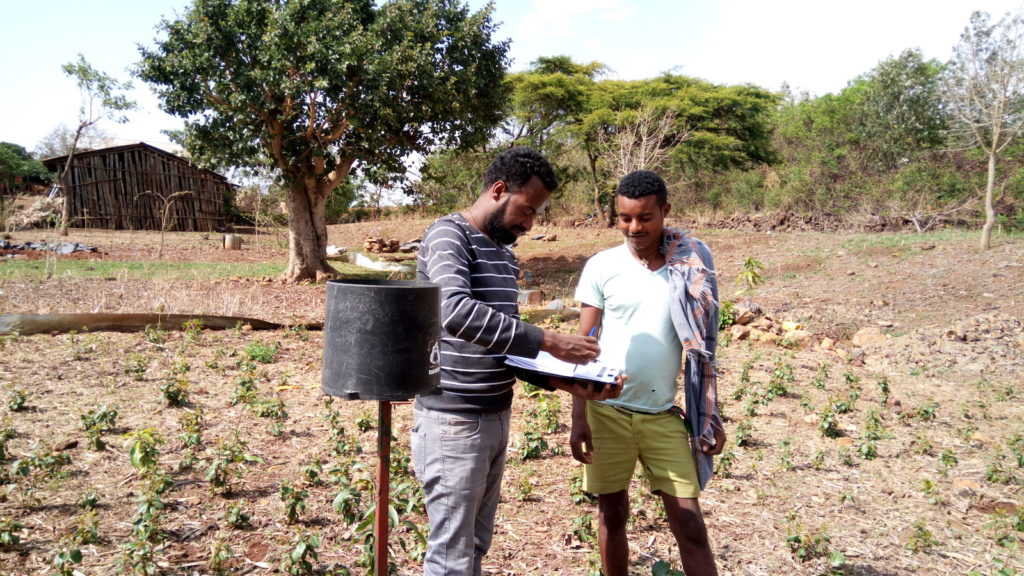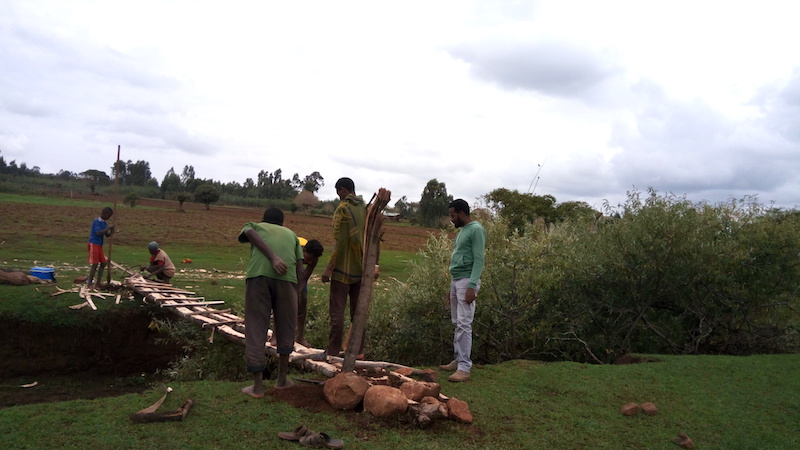In 2017-2018, Feleke Kuraz Sishu joined ILSSI’s capacity development program for graduate students, and he investigated the impacts of agricultural intensification on surface and groundwater in the Ethiopian Highlands. He is a student at the Bahir Dar Institute of Technology, Bahir Dar University, Ethiopia, and he is currently at the university in Calgary, British Columbia, for a three-month study experience.

What were you studying while you were working with ILSSI?
I studied how agricultural intensification impacts nutrient and pesticide fluxes in streams and shallow groundwater systems in the Ethiopian Highlands. I monitored two agricultural watersheds, Robit and Dangila, between 2017 and 2018. We sampled water from streams during storms and dry periods, and we collected groundwater samples from more than 30 wells located either in rainfed or irrigated fields. Then we analyzed the level of agro-chemicals in the water.

What’s the most surprising thing you found?
We found nitrate in the shallow groundwater samples, with a higher concentration in samples taken on upper and mid-level slopes, than in those taken at the bottom of slopes. Having a high concentration of nitrate in groundwater poses a risk to human health, especially if the water is used for drinking.
The presence of nitrate can be explained by different things: first, farmers are beginning to fertilize their rainfed and irrigated fields on the upper and mid-level slopes, meaning that they add nitrogen, which is a critical plant nutrient. However, when crops are not able to use up all the nitrogen, it leaches into the groundwater and causes high concentrations of nitrate. We discovered that in some areas, the level of nitrate exceeded the permissible 10mg/l limit for drinking water. It is likely that intensified farming and fertilizer application are among the causes for high levels of nitrate in the groundwater.
When we looked at streams, we found both nitrate and dissolved phosphorus, which is another common component of fertilizer. In both watersheds, the level of nitrate and phosphorus in streams exceeded the threshold limit more than fivefold. When the streams empty out into Lake Tana, which is the largest freshwater body in Ethiopia, the result is an explosive growth of algae and other plants. This threatens the lake’s ability to provide water, fish and other benefits.
Our results indicate that degraded landscapes with poor watershed management activities, combined with high rainfall during the rainfed farming season, contributed to nitrogen leaching and likely caused the increased levels of nitrate and dissolved phosphorus.
Finally, we also detected pesticides used by farmers in streams and shallow wells. The concentration exceeded the threshold limits set by the World Health Organization of 0.1 μg/l for each kind of pesticide and 0.5 μg/l in total.

What changes do you hope your work will help achieve?
Our findings from these two watersheds point to poor watershed management, intensive farming and the threat from increasing use of fertilizer in the uplands. Based on our observations of Lake Tana, which is suffering from a water hyacinth invasion brought on by the excessive nutrients delivered by streams, these issues exist across the northern Ethiopian Highlands.
The health and environmental risks stemming from these issues should be a major cause of alarm, and therefore we have worked to raise these issues and share recommendations with government officers, non-government actors, community watershed managers and communities themselves in the area.
For example, we have informed these stakeholders about which wells hold groundwater that is so polluted by nitrate that it should not be used for drinking. We have also started discussions about what changes communities can make to limit pesticide use, and we have raised the issue at the policy level, since Ethiopia currently has no regulations on pesticides for agricultural use.
We hope that our recommendations and engagement with stakeholders will lead to changes that can safeguard the clean water supply and support environmentally sustainable agricultural intensification.
What do you think is the biggest challenge for scaling farmer-led irrigation?
From a water quality perspective, the fact that both surface and groundwater is so vulnerable to contamination from pesticide and fertilizer use is the biggest challenge. That’s one reason we need to identify areas that are suitable for irrigation – and thus agricultural intensification – but at the same time less vulnerable to pollution from agro-chemicals. This is a pressing challenge for local farmers, and therefore an opportunity to collaborate with them on research for development activities.
What is your advice to other students looking to work with Feed the Future innovation labs?
I am very thankful to ILSSI for funding and providing all requested facilities during my research. I got an opportunity to work with students from different countries, with researchers and with different institutions – this helped me gain skills, share experiences and develop future collaborations. Therefore, I would like to advice the students interested in working with ILSSI that it is a great chance to conduct research and network with scholars from around the world. Thank you!
On an ongoing basis, ILSSI supports a number of graduate and honor’s undergraduate students from academic institutions in Ethiopia, Ghana and Tanzania. We pair them with experienced scientists from our partner organizations, who mentor the students through proposal, research design, field work, data collection, analysis and presentation of results. These capacity development efforts underpin the long-term scaling and sustainability of small scale irrigation in sub-Saharan Africa. In this case, Feleke Kuraz Sishu’s work was co-supported by the Feed the Future Sustainable Intensification Lab.


